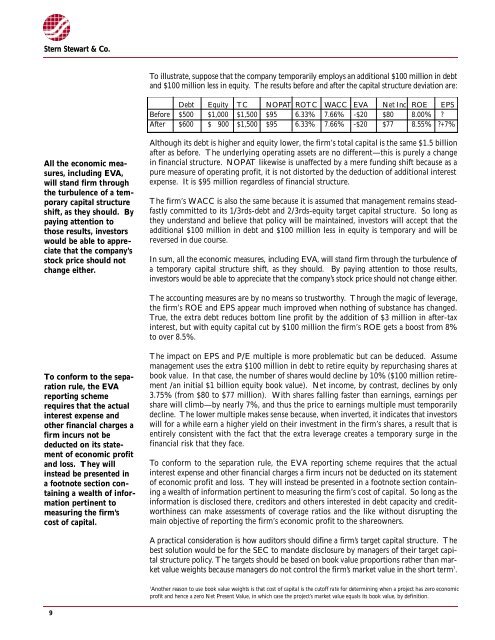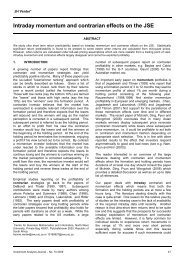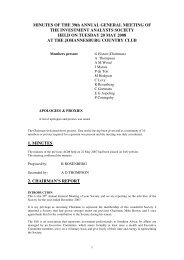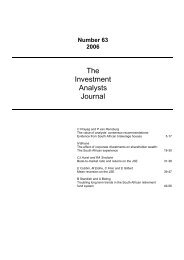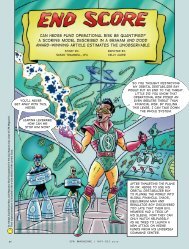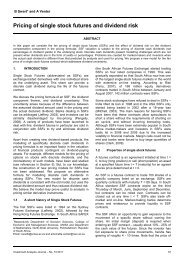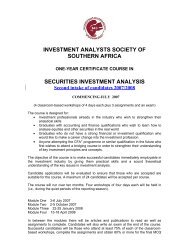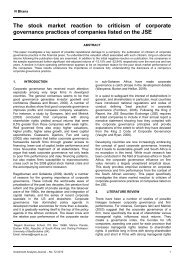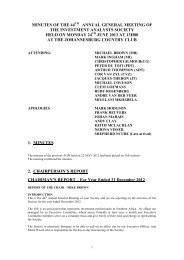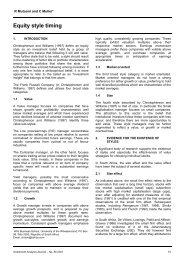Accounting is Broken - Investment Analysts Journal
Accounting is Broken - Investment Analysts Journal
Accounting is Broken - Investment Analysts Journal
Create successful ePaper yourself
Turn your PDF publications into a flip-book with our unique Google optimized e-Paper software.
Stern Stewart & Co.<br />
To illustrate, suppose that the company temporarily employs an additional $100 million in debt<br />
and $100 million less in equity. The results before and after the capital stru c t u re deviation are :<br />
D e b t E q u i t y T C N O PAT R O T C WA C C E VA Net Inc R O E E P S<br />
B e f o re $ 5 0 0 $ 1 , 0 0 0 $ 1 , 5 0 0 $ 9 5 6 . 3 3 % 7 . 6 6 % - $ 2 0 $ 8 0 8 . 0 0 % ?<br />
A f t e r $ 6 0 0 $ 900 $ 1 , 5 0 0 $ 9 5 6 . 3 3 % 7 . 6 6 % - $ 2 0 $ 7 7 8.55% ?+7%<br />
All the economic meas<br />
u res, including EVA ,<br />
will stand firm thro u g h<br />
the turbulence of a temp<br />
o r a ry capital stru c t u re<br />
shift, as they should. By<br />
paying attention to<br />
those results, investors<br />
would be able to appreciate<br />
that the company’s<br />
stock price should not<br />
change either.<br />
Although its debt <strong>is</strong> higher and equity lower, the firm’s total capital <strong>is</strong> the same $1.5 billion<br />
after as before. The underlying operating assets are no different—th<strong>is</strong> <strong>is</strong> purely a change<br />
in financial structure. NOPAT likew<strong>is</strong>e <strong>is</strong> unaffected by a mere funding shift because as a<br />
pure measure of operating profit, it <strong>is</strong> not d<strong>is</strong>torted by the deduction of additional interest<br />
expense. It <strong>is</strong> $95 million regardless of financial structure.<br />
The firm’s WACC <strong>is</strong> also the same because it <strong>is</strong> assumed that management remains steadfastly<br />
committed to its 1/3rds-debt and 2/3rds-equity target capital structure. So long as<br />
they understand and believe that policy will be maintained, investors will accept that the<br />
additional $100 million in debt and $100 million less in equity <strong>is</strong> temporary and will be<br />
reversed in due course.<br />
In sum, all the economic measures, including EVA, will stand firm through the turbulence of<br />
a temporary capital stru c t u re shift, as they should. By paying attention to those re s u l t s ,<br />
investors would be able to appreciate that the company’s stock price should not change either.<br />
The accounting measures are by no means so tru s t w o rt h y. Through the magic of leverage,<br />
the firm’s ROE and EPS appear much improved when nothing of substance has changed.<br />
True, the extra debt reduces bottom line profit by the addition of $3 million in after-tax<br />
interest, but with equity capital cut by $100 million the firm’s ROE gets a boost from 8%<br />
to over 8.5%.<br />
To conform to the separation<br />
rule, the EVA<br />
re p o rting scheme<br />
re q u i res that the actual<br />
i n t e rest expense and<br />
other financial charges a<br />
f i rm incurs not be<br />
deducted on its statement<br />
of economic pro f i t<br />
and loss. They will<br />
instead be presented in<br />
a footnote section containing<br />
a wealth of information<br />
pertinent to<br />
measuring the firm ’s<br />
cost of capital.<br />
The impact on EPS and P/E multiple <strong>is</strong> more problematic but can be deduced. Assume<br />
management uses the extra $100 million in debt to retire equity by repurchasing shares at<br />
book value. In that case, the number of shares would decline by 10% ($100 million retirement<br />
/an initial $1 billion equity book value). Net income, by contrast, declines by only<br />
3.75% (from $80 to $77 million). With shares falling faster than earnings, earnings per<br />
share will climb—by nearly 7%, and thus the price to earnings multiple must temporarily<br />
decline. The lower multiple makes sense because, when inverted, it indicates that investors<br />
will for a while earn a higher yield on their investment in the firm’s shares, a result that <strong>is</strong><br />
entirely cons<strong>is</strong>tent with the fact that the extra leverage creates a temporary surge in the<br />
financial r<strong>is</strong>k that they face.<br />
To conform to the separation rule, the EVA reporting scheme requires that the actual<br />
interest expense and other financial charges a firm incurs not be deducted on its statement<br />
of economic profit and loss. They will instead be presented in a footnote section containing<br />
a wealth of information pertinent to measuring the firm’s cost of capital. So long as the<br />
information <strong>is</strong> d<strong>is</strong>closed there, creditors and others interested in debt capacity and creditworthiness<br />
can make assessments of coverage ratios and the like without d<strong>is</strong>rupting the<br />
main objective of reporting the firm’s economic profit to the shareowners.<br />
A practical consideration <strong>is</strong> how auditors should difine a firm ’s target capital stru c t u re. The<br />
best solution would be for the SEC to mandate d<strong>is</strong>closure by managers of their target capital<br />
stru c t u re policy. The targets should be based on book value pro p o rtions rather than market<br />
value weights because managers do not control the firm ’s market value in the short term 7 .<br />
7<br />
Another reason to use book value weights <strong>is</strong> that cost of capital <strong>is</strong> the cutoff rate for determining when a project has zero economic<br />
p rofit and hence a zero Net Present Value, in which case the pro j e c t ’s market value equals its book value, by definition.<br />
9


